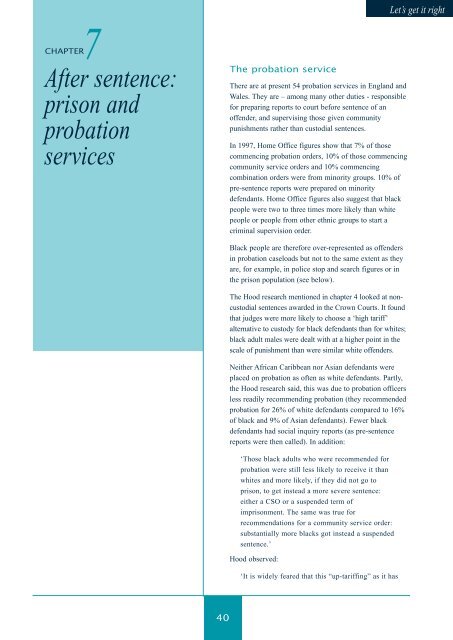Let’s <strong>get</strong> <strong>it</strong> <strong>right</strong>CHAPTER7After sentence:prison <strong>and</strong>probationservicesThe probation serviceThere are at present 54 probation services in Engl<strong>and</strong> <strong>and</strong>Wales. They are – among many other duties - responsiblefor preparing reports to court before sentence of anoffender, <strong>and</strong> supervising those given commun<strong>it</strong>ypunishments rather than custodial sentences.In 1997, Home Office figures show that 7% of thosecommencing probation orders, 10% of those commencingcommun<strong>it</strong>y service orders <strong>and</strong> 10% commencingcombination orders were from minor<strong>it</strong>y groups. 10% ofpre-sentence reports were prepared on minor<strong>it</strong>ydefendants. Home Office figures also suggest that blackpeople were two to three times more likely than wh<strong>it</strong>epeople or people from other ethnic groups to start acriminal supervision order.Black people are therefore over-represented as offendersin probation caseloads but not to the same extent as theyare, for example, in police stop <strong>and</strong> search figures or inthe prison population (see below).The Hood research mentioned in chapter 4 looked at noncustodialsentences awarded in the Crown Courts. It foundthat judges were more likely to choose a ‘high tariff’alternative to custody for black defendants than for wh<strong>it</strong>es;black adult males were dealt w<strong>it</strong>h at a higher point in thescale of punishment than were similar wh<strong>it</strong>e offenders.Ne<strong>it</strong>her African Caribbean nor Asian defendants wereplaced on probation as often as wh<strong>it</strong>e defendants. Partly,the Hood research said, this was due to probation officersless readily recommending probation (they recommendedprobation for 26% of wh<strong>it</strong>e defendants compared to 16%of black <strong>and</strong> 9% of Asian defendants). Fewer blackdefendants had social inquiry reports (as pre-sentencereports were then called). In add<strong>it</strong>ion:‘Those black adults who were recommended forprobation were still less likely to receive <strong>it</strong> thanwh<strong>it</strong>es <strong>and</strong> more likely, if they did not go toprison, to <strong>get</strong> instead a more severe sentence:e<strong>it</strong>her a CSO or a suspended term ofimprisonment. The same was true forrecommendations for a commun<strong>it</strong>y service order:substantially more blacks got instead a suspendedsentence.’Hood observed:‘It is widely feared that this “up-tariffing” as <strong>it</strong> has40
RACE AND JUSTICE <strong>2000</strong>CHAPTER 7 AFTER SENTENCEbeen commonly <strong>and</strong> crudely called is a factorwhich puts blacks at more risk for receiving acustodial sentence should they re-appear on freshcharges.’It is therefore important that probation services can offerto sentencers a range of non-custodial penaltiesappropriate for all members of the commun<strong>it</strong>y.Probation services, ACOP (the Association of ChiefOfficers of Probation) <strong>and</strong> the staff associations NAPO(National Association of Probation Officers) <strong>and</strong> ABPO(Association of Black Probation Officers) have beenworking to achieve equal<strong>it</strong>y in both pre-sentence reports<strong>and</strong> provision of commun<strong>it</strong>y punishments for many years.At local level, different services have a range of projectstar<strong>get</strong>ed at minor<strong>it</strong>y offenders <strong>and</strong> work closely w<strong>it</strong>h otherstatutory <strong>and</strong> voluntary agencies to develop these further.In <strong>it</strong>s work w<strong>it</strong>h Area Comm<strong>it</strong>tees, NACRO has comeacross many examples of good practice that could serveas models for other areas.Greater Manchester Probation Service (GMPS) providedsupport <strong>and</strong> resources to enable the first ever conferenceof black prisoner support groups to be held. It alsoconducted user surveys: in 1994 a survey of informationon 50 black offenders looked at offence type, risk to thepublic <strong>and</strong> sentence, as well as personal details such asage. Key issues identified were: the high risk ofimprisonment faced by black offenders; low take up ratefor probation supervision; <strong>and</strong> black prisoners servinglong sentences.In 1997, a report called ‘Black Voices Telling Us HowThey Feel’ was prepared for GMPS by the Partners ofPrisoners <strong>and</strong> Families Support Group <strong>and</strong> the BlackPrisoners Support Group. The researchers interviewed 36black probation service users to look at what services <strong>and</strong>facil<strong>it</strong>ies were offered, <strong>and</strong> what barriers prevented moreuse of these services.The survey found that users had a pos<strong>it</strong>ive view of theprobation service but more needed to be done to makesure that they were aware of what was on offer. There wasa difference between offenders on probation orderscompared to those being supervised after custody, whowere more negative <strong>and</strong> viewed supervision as a doublepunishment. The three women in the survey pointed outthe problems that arose because of their caringresponsibil<strong>it</strong>ies.In 1996 GMPS commissioned an independent researcherto evaluate hostel provision for offenders. Only about 5%of residents came from minor<strong>it</strong>y ethnic groups, althoughat the time they made up 13% of the local prisonpopulation. The research looked at why there were so fewminor<strong>it</strong>y clients in supported offender hostels, <strong>and</strong> whatorganisations could do to make their projects moreculturally sens<strong>it</strong>ive to the needs of minor<strong>it</strong>y residents. Itconcluded that:‘Desp<strong>it</strong>e a strong desire to develop a moreculturally sens<strong>it</strong>ive service for ethnic minor<strong>it</strong>yresidents of offender accommodation, the major<strong>it</strong>yof providers find <strong>it</strong> difficult to implement effectivepolicies which bring about change.’The report made recommendations about referrals, linksto minor<strong>it</strong>y ethnic agencies, mon<strong>it</strong>oring, training, creatinga multi-cultural environment, customer surveys, <strong>and</strong> theemployment of black staff. It recommended that eachaccommodation project adopt an action plan forimplementing these recommendations.This approach to work on <strong>race</strong> helps to highlight keyissues for future probation service work:Youth offending teamsThe Crime <strong>and</strong> Disorder Act 1998 includes a newstructure for national <strong>and</strong> local youth <strong>justice</strong> work,along w<strong>it</strong>h new sentencing powers to deal w<strong>it</strong>h youngoffenders. Probation services will need to work closelyw<strong>it</strong>h other agencies in youth offending teams <strong>and</strong> toensure that all young people receive fair treatmentunder the new provisions <strong>and</strong> have equal access topos<strong>it</strong>ive programmes to counter offending behaviour.Government guidance on establishing youth offendingteams includes the need for YOTs to undertake ethnicmon<strong>it</strong>oring, to take account of information publishedunder s95 of the Criminal Justice Act 1991 <strong>and</strong>,importantly, to consult local commun<strong>it</strong>ies to ensureyouth <strong>justice</strong> arrangements deal fairly w<strong>it</strong>h all youngpeople.The Youth Justice Board for Engl<strong>and</strong> <strong>and</strong> Wales,established in September 1998, will mon<strong>it</strong>or the youth<strong>justice</strong> system.Support for voluntary <strong>and</strong> commun<strong>it</strong>y groupsProbation services should work closely w<strong>it</strong>h <strong>and</strong>support commun<strong>it</strong>y-based groups working w<strong>it</strong>hoffenders, as in the example above in Manchester, or41

















